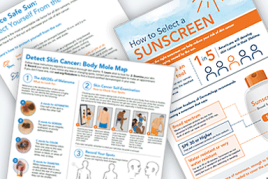Warts: Causes
You cannot get a wart from touching a toad or a frog.
Even if you kiss a frog or toad, you won’t get a wart.

What causes warts?
Viruses called human papillomaviruses (HPV) cause warts. There are more than 200 different types of HPV. Some, but not all, cause warts.
You can get a wart(s) when one of the viruses that can cause warts infects your skin. This can happen when you have a cut, scrape, or other injury that creates a break in your skin and you touch:
A wart on someone’s body
An object infected with a wart-causing HPV, such as a towel, locker room floor, or pool deck
The break in your skin doesn’t need to be noticeable. For example, shaving creates microtears in the skin. HPV can infect you through a microtear.
After HPV infects your skin, you won’t see a wart right away. It usually takes a few months for a wart to grow large enough to see.
Can HPV cause cancer?
Some types of HPV that spread through sexual contact can cause cancer. Sexually transmitted (vaginal, anal, oral) types of HPV are categorized as either low risk or high risk.
Low-risk HPV types can cause warts on or around the genitals, anus, mouth, or throat. While rare, some low-risk types also cause cancer. However, the high-risk types cause most cancers.
The most common type of cancer caused by an HPV infection is cervical cancer. HPV can also cause cancer of the anus, vulva, vagina, penis, mouth, or throat. Some people develop cancer around a fingernail or toenail.
The HPV vaccine helps protect against the types of HPV that:
Cause genital warts
Increase a person's risk of developing cancer due to HPV
The Centers for Disease Control and Prevention (CDC) recommends getting the first dose of this vaccine at 11 or 12 years of age. The second dose is given 6 to 12 months later. Getting vaccinated before being exposed to the virus protects children from getting cancers caused by HPV later in life.
If you get vaccinated when you are 15 years of age or older, you’ll need a third dose of the HPV vaccine.
The HPV vaccine is typically not given to people who are 26 years of age or older. However, a doctor may recommend this vaccine for some people who are 27 years of age or older.
The HPV vaccine protects against genital warts and HPV-related cancers. It cannot lower your risk of getting other types of warts.
Who gets warts?
Warts are common in children and teens.
Kids frequently touch each other’s skin, have a cut or scrape, or share unwashed clothing or towels. Doing any of these makes it easier to pick up a virus that causes warts.

While warts are common in children and teens, anyone can get warts. Some people are more susceptible than others. You have a greater likelihood of developing a wart if you:
Have skin that’s softened by water
Bite or pick at your nails
Walk barefoot in a pool area, communal shower, gym, or locker room
Share unwashed towels, socks, or other items
Have atopic dermatitis (eczema) along with asthma or hay fever
Have a weakened immune system, such as due to an organ transplant, cancer, or AIDS
Handle raw meat, poultry, or fish, such as in a butcher shop or slaughterhouse
Are pregnant
What causes warts to spread?
Warts can spread to another person. Warts can also spread from one area of your body to another. This can happen when you touch your wart and then touch:
An area of your body with broken skin
Another person in an area with broken skin
When you do this, you can spread the wart-causing virus.
People who have a weakened immune system may develop widespread warts. A weakened immune system may make it difficult for the body to fight wart-causing viruses. This can cause a person to develop many warts.
If you develop many warts, have a wart that won’t go away, or feel embarrassed by a wart, treatment can help you get rid of the wart(s). Find out how dermatologists treat and clear these growths at Warts: Diagnosis and treatment.
Images
Getty Images
References
Centers for Disease Control and Prevention. “Human papillomavirus.” Last updated August 20, 2024. Last accessed February 27, 2025.
Goldstein BG, Goldstein AO, et al. (section editors: Dellavalle RP, Levy ML, et al.). “Cutaneous warts (common, plantar, and flat warts)” UpToDate. Last updated: January 2, 2025. Last accessed: March 27, 2025.
National Cancer Institute. “HPV and cancer.” Last updated January 31, 2025. Last accessed March 27, 2025.
Silverberg JI, Silverberg NB. “Childhood atopic dermatitis and warts are associated with increased risk of infection: A US population-based study.” J Allergy Clin Immunol. 2014 Apr;133(4):1041-7.
Sterling JC. “Human papillomavirus infections.” In: Kang S, Amagai M, et al. Fitzpatrick’s Dermatology (ninth edition). McGraw Hill Education, New York, 2019: 3097-3100.
Written by:
Paula Ludmann, MS
Reviewed by:
Laurel Geraghty, MD, FAAD
Carrie L. Kovarik, MD, FAAD
William Warren Kwan, MD, FAAD
Morgan Murphrey, MD, FAAD
Sanna Ronkainen, MD, FAAD
Last updated: 5/8/25
 Atopic dermatitis: More FDA-approved treatments
Atopic dermatitis: More FDA-approved treatments
 Biosimilars: 14 FAQs
Biosimilars: 14 FAQs
 How to trim your nails
How to trim your nails
 Relieve uncontrollably itchy skin
Relieve uncontrollably itchy skin
 Fade dark spots
Fade dark spots
 Untreatable razor bumps or acne?
Untreatable razor bumps or acne?
 Tattoo removal
Tattoo removal
 Scar treatment
Scar treatment
 Free materials to help raise skin cancer awareness
Free materials to help raise skin cancer awareness
 Dermatologist-approved lesson plans, activities you can use
Dermatologist-approved lesson plans, activities you can use
 Find a Dermatologist
Find a Dermatologist
 What is a dermatologist?
What is a dermatologist?